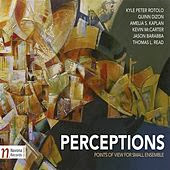For what it's worth, a little personal experience related to this music. I started my classical music listening with some of the Russian masters. It was almost by chance. My dad had an LP of Tchaikovsky's Fifth Symphony, as played nicely by Mitropoulos and the New York Philharmonic, and I listened closely to it when he'd put it on. This was by age three. I didn't understand what this symphonic music was all about but I liked it. Then when I was in 4th grade a visit to the old Sam Goody outlet in Paramus, NJ, ended up in my request for my dad to buy a budget RIAS Symphony recording of Stravinsky's
Firebird. It had a picture of a bird in flight on the cover, fire streaming from its outstretched wings and I thought that looked very cool. I told my dad we should buy that one. He asked, "are you sure?" but yes, I was, so we grabbed it along with something for him, I believe Peggy Lee (or was it Julie London?) with the Page Cavanaugh Trio.
The Firebird seemed like it came from another world. In time I grew quite fond of the music and it was the backbone of my first tiny collection of classical records. By the time I was around 14 I was eager to know more. And my entanglement with Stravinsky led eventually at that time to the Rites of Spring, a transforming work to hear if there was one. But to focus on what matters today, by chance the local record shop had a recording of Rachmaninov's Symphony No. 1 by Ormandy and the Philadelphia Orchestra. I bought it for $2.99, took it home and was little-by-little taken over by it. The minor mode darkness of the work, it's edge-of-modernity stance, its so-Russian sensibility made it quickly a favorite. And as it turned out the Ormandy recording was an excellent one, and so naturally became a benchmark to me when I heard other performances of the work later on.
Cut to the immediate present. Leonard Slatkin and the Detroit Symphony Orchestra chime in with a continuation of their Rachmaninov series, with an beautiful recording of Rachmaninov's Symphony No. 1 (Naxos 8.573234) paired with the composer's milestone work in the dark realm, "The Isle of the Dead". I covered Slatkin's Naxos recording of Rachmaninov's Symphony No. 3 on these pages this past May 20th, which I liked a great deal. And he comes through again with a fine performance today. Like his version of No. 3, Slatkin and his Detroit associates take pains to bring out a detailed panorama (of both the symphony and the Isle work) where for the most part the wind and horns, the tympani and strings are all extraordinarily well-balanced, unlike some string-heavy recordings I have heard. And everything has that very idiomatic early-mid period Rachmaninovian dark passion.
I remember reading somewhere how the young Rachmaninov was utterly devastated by the symphony's tepid or hostile reception at its premiere and second performances, and indeed grew to dislike it so much that he withdrew the work and shelved it. It was never again performed during his lifetime. This might explain how the work has been less often performed in my lifetime than his second and third symphonies. To my mind however the first is the most original of the three, certainly the most exciting and the most daring. It has tremendous power and mood in the right hands. I don't want to imply that the other symphonies aren't worthwhile. They too are marvelous. But the first is the preferred one for me.
And the right hands are surely Leonard Slatkin's and the Detroit Symphony. It's an excellent performance, nearly as great as the Ormandy one I grew up with. There are a few passages, mostly in the final movement that I think Ormandy gets the edge on, but they are not many and in fact the Detroit version here has maybe even more kinetic energy and beautiful wind playing, so perhaps it evens off in the end. At the Naxos price this is certainly a version you can grow with and revel in.
And the "Isle of the Dead" as performed gets a thumbs-up from me as well. Those who know the work will of course remember the principal theme, what at first sounds like an ostinato (in five) but then continually develops and transforms into something quite remarkable. I don't know if any of the principal jazz fusion/prog rock exponents ever listened to the work, but it does seem to be a precursor for what went down in those genres by the seventies. Yet of course Rachmaninov goes on to develop thematic material in ways the fusionists did and probably could not manage. But then they were more concerned to create a springboard for improvisations, though face it, more thematic development wouldn't have hurt that either.
These are two supremely dark and dramatic works that pair especially well together and are given loving attention from Maestro Slatkin and the Detroit conflagration. I have heard nothing on disk that seriously surpasses these versions, so I of course enthusiastically recommend this recording without hesitation!

.jpg)






.jpg)









.jpg)











.jpg)
.jpg)





